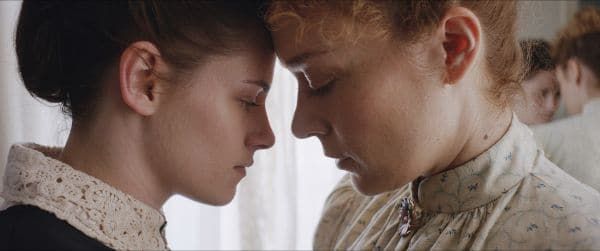Eye For Film >> Movies >> Lizzie (2018) Film Review
Lizzie
Reviewed by: Owen Van Spall

Lizzie Borden is perhaps not a household name in the UK, but what went on in her household back in 1892 in Fall River, Massachusetts made her notorious. Lizzie Andrew Borden (July 19, 1860 – June 1, 1927) was an American woman who was the main suspect in the August 4, 1892, axe murders of her father and stepmother. Borden was ultimately tried and acquitted of the murders, but the deaths cast a shadow over her life and she became a cause celebre during and after her life, the story endlessly dissected in podcasts, essays and works of fiction. She has since even been claimed as a kind of feminist symbol.
That latter development seems to have been very much in the mind of director Craig William Macneill. Rather than tease us with the question of, 'Did she do it?’ (spoiler alert; the narrative eventually reveals who swung the axe with no doubt left about it), he instead turns his focus, via a script from writer Bryce Kass, towards the miserable and oppressive domestic situation a young woman like Lizzie could find herself trapped in. This is a grim, austere story of the pressure cooker of frustration, rage and fear that results when the patriarchy squeezes just as tight as the corsets of the time. It is more dogged than devastating, ultimately, though given the subject matter it is certainly a timely take on the murder mystery.

With the presence of Chloë Sevigny and Kristen Stewart as the two leads, Macneill has plenty of female star power on his hands, though it is really Sevigny’s show. Following a pre-credit flash-forward to the bloody aftermath of the murder, we jump back to a scene in Lizzie’s (Sevigny) home life: an attempted late-night trip to the theatre meets with vicious disapproval from her stern father Andrew while the stepmother she cares nothing for looks on sullenly. As played by Sevingny, Lizzie is a figure of trembling energy and a barely repressed tongue who is strikingly blunt in her expressions of loathing for her father, a plainly dressed and miserly type who keeps his wealthy household in candlelit gloom despite the availability of gas lamps.
Lizzie’s demonstrated love of the arts suggests a creativity and passion for culture that is slowly being snuffed out by her controlling parent. Lizzie, we also learn, is in her 30s and unwed, and thus seen by the family as of little further use in terms of preserving their legacy. An equal match for Sevigny’s impudent volleys of sarcasm and indignation is the puritanical chill emanating from actor Jamey Sheridan as Andrew Borden. He is one of those actors who looks and sounds as though he could be simply dropped back into that time period and he’d fit right in. Andrew’s nightly rapes of new Irish immigrant maid Bridget (Kristen Stewart, stuck in mousey mode) only enrage and frighten Lizzie more, not least given the sexual attraction between the two women that has sprung up over the autumn weeks.
The decision to focus in the film’s second half on the clumsy beginnings of a lesbian relationship between two women who barely even know each other, but are desperate to share their isolation with someone, offers the film a much-needed release from what is otherwise a somewhat one-note journey of oppression and breakdown before the bloody finale we know is coming. Already suffering dizzy spells and epileptic fits which render her exhausted and frightened, Lizzie also fears her father intends to pass the management of the family fortune, and her inheritance, to her pervert uncle. As a woman in 1800s America, she has no say in any of this, and this would mean any chance of long-term escape with Bridget would be closed off. Lizzie and Bridget understandably cling to each other even harder as the walls close in, and, always under observation in the house, have to communicate via letters passed to each other in the corridors as if they are two schoolchildren in class. It is a painfully touching gesture to see.
Inevitably, things cannot stay in this unstable state and - somewhat mechanistically - we see Lizzie reach breaking point as the incidents of humiliation and threats pile up. Still, by this point we have had a brutally effective portrait of a woman’s domestic prison drawn for us, and Sevigny gets a few juicy final act scenes that help continue the process, begun earlier, of wrong-footing us about how much of an addled victim Lizzie really is. Far from being an unstable, random killer who acted unconsciously in a fit of despair, we get hints that Lizzie might in fact be all too aware of not only how to ‘get away with it’, but keen to reap the benefits of the power that being known as a murderess might offer, not least when it comes to unsettling any man who challenges her from that point on.
Reviewed on: 28 Oct 2018

















